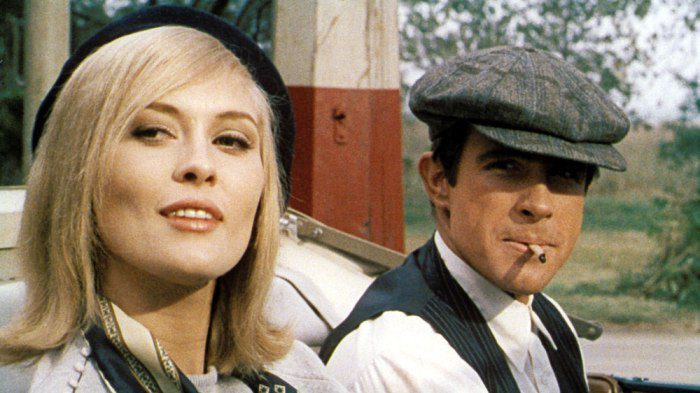
Bonnie and Clyde (1967, dir. Arthur Penn) remains one of the landmark films marking the start of the New Hollywood era, breaking many cinematic taboos, especially in the portrayal of crime, sex and violence. With improvements in technology, cameras became lighter and easier to carry around, as well as creating new ways to film (such as the zoom lens creating dramatic zoom effects). Penn uses these new possibilities in camera movement and filming along with editing techniques prominent in French New Wave to not only overwhelm and shock the viewer, but also portray it realistically – Bonnie and Clyde was notably one of the first films to use blood extensively in their violent scenes. In this way, the violence is not seen as theatrics on the screen but rather one that is weighted with consequence and message – especially in the era of the highly visible and televised Vietnam War.
The first scene of ‘violence’ starts out relatively tame, and can even be argued as to whether it is ‘violent’ at all – Clyde shooting at a row of bottles for shooting practice, and then later inducting Bonnie into the act. The interesting thing about this shot is that the camera shoots from the perspective of the bottle, facing Clyde, essentially bringing the audience to gunpoint. While there is no harm done, the way the shot is framed makes it direct and confrontational, setting the ground for further violence later in the film.
The next scene where Clyde shoots is the sign of possession placed by the bank at the front of the abandoned house. Under that particular context, the shooting can be seen as an anti-establishment act of rebellion: it is here that Clyde formally declares, ‘We rob banks.’ Hence, the violence here is used as a way to cement the path of Bonnie and Clyde – their resolve is decided by their declaration, which continues to their death. It is also interesting to note the constant attention that the camera gives to signs (road signs, shop signs, etc), often devoting exclusive close-ups to them. This use of the zoom not only helps to give context for the start of each scene, but more importantly establishes symbols/places of authority, and Bonnie and Clyde as defying that authority – in their first ‘real’ bank heist, Clyde takes the time to shoot the signboard at the bank’s entrance even when they were in a haste to get away.
And all the acts of violence culminates into the finale – the camera starts off at a slow pace, alternating from Bonnie and Clyde’s point of view and establishing shots to show their car pulling to the side, while gradually zooming into their faces as they realise their predicament, distorting the viewpoint for added dramatic flair. At the same time, the shots become quicker and shorter, focusing on very short, staccatoed movements such as the actions of heads moving and turning, the flock of pigeons flying from the tree and the disturbance in the tress, intercutting between them to create a rhythmic tension to build up to the climax. This then escalates to the final shooting – where the durations of the shots become longer, the shots with the bodies of Bonnie and Clyde falling intentionally slowed down to show the extent of the violence and carnage on their defenceless bodies. Here the rhythm of the scene is replaced by the sound of the guns, keeping the height of the tension and thus allowing for the editor to play around with longer cuts. The shots also become longer and further away, to better show to movement of the corpses as they hit the ground. In this way, the camera and the editing work together in a tight montage to showcase the final escalation of violence – despite the lack of a musical score, the tension is successfully built up with the intercutting shots right until the climax, where it then gets stretched out (and played over again – the montage included shots of the same action from different vantage points and angles) for the audience to fully take in the horror of the couples’ deaths – unlike their meeting and journey together, their final death is far from romantic – and the use of physical effects and blood makes sure that the stark nature of the violence is clear. The message of this portrayal of violence seems to be ambivalent as well – is the violent end of Bonnie and Clyde their just desserts for their life of crime, or is this level of violence unwarranted for two small time robbers? Either way, the violence marks an end to their young lives and their life of romance, sex and crime.